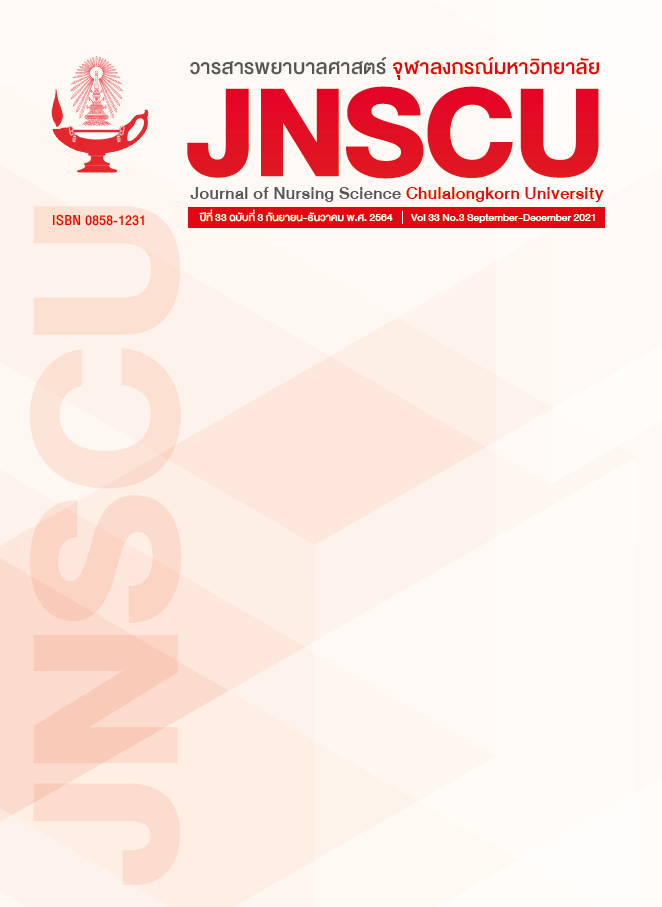ผลของโปรแกรมการพยาบาลเน้นการลดความเจ็บปวดต่อความกลัว การใส่สายสวนทางหลอดเลือดดำของเด็กวัยก่อนเรียน
คำสำคัญ:
การพยาบาล, ความกลัว, การใส่สายสวนทางหลอดเลือดดำ, ความเจ็บปวด, เด็กวัยก่อนเรียนบทคัดย่อ
วัตถุประสงค์: เพื่อศึกษาผลของโปรแกรมการพยาบาลเน้นการลดความเจ็บปวดต่อความกลัวการใส่สายสวนทางหลอดเลือดดำในเด็กวัยก่อนเรียน
รูปแบบการวิจัย: การวิจัยแบบกึ่งทดลอง
วิธีดำเนินการวิจัย: กลุ่มตัวอย่าง คือ ผู้ป่วยเด็กวัยก่อนเรียนที่ได้รับการรักษาโดยการใส่สายสวนทางหลอดเลือดดำ ณ หอผู้ป่วยกุมารเวชกรรม โรงพยาบาลศูนย์ราชบุรี จำนวน 60 คน โดยการสุ่มเข้ากลุ่มทดลองหรือกลุ่มควบคุมและจับเข้าคู่กันด้วยการพิจารณาจากอายุและประสบการณ์การใส่สายสวนทางหลอดเลือดดำ ผู้ป่วยเด็กวัยก่อนเรียนในกลุ่มควบคุมได้รับการพยาบาลเพื่อลดความกลัวตามปกติ ขณะที่กลุ่มทดลองได้รับโปรแกรมการพยาบาลเน้นการลดความเจ็บปวด เก็บรวบรวมข้อมูลโดยใช้แบบสังเกตพฤติกรรมความกลัวการใส่สายสวนทางหลอดเลือดดำของผู้ป่วยเด็กวัยก่อนเรียน โดยผ่านการตรวจสอบความตรงเชิงเนื้อหาจากผู้ทรงคุณวุฒิ 5 ท่าน มีค่าดัชนีความตรงตามเนื้อหาเท่ากับ .98 และค่าความเที่ยงของการสังเกตเท่ากับ .94 วิเคราะห์ข้อมูลโดยใช้สถิติพรรณนาและใช้สถิติทดสอบที (t-test)
ผลการวิจัย: ความกลัวการใส่สายสวนทางหลอดเลือดดำของเด็กวัยก่อนเรียนกลุ่มที่ได้รับโปรแกรมการพยาบาลเน้นการลดความเจ็บปวดน้อยกว่ากลุ่มที่ได้รับการพยาบาลตามปกติ อย่างมีนัยสำคัญทางสถิติที่ระดับ .05
สรุป: ผลการศึกษานี้แสดงให้เห็นว่าโปรแกรมการพยาบาลเน้นการลดความเจ็บปวดสามารถลดความกลัวการใส่สายสวนทางหลอดเลือดดำของเด็กวัยก่อนเรียนได้
เอกสารอ้างอิง
Alisa S, Khunkaew S, Udomlerd M. Managing
Fear Needle Pain in Children: Nursing
Practice in Pediatric care. Journal of The
Royal Thai Army Nurses 2017; 8 (suppl):
-31. (in Thai)
World Health Organization. Pocket book of
hospital care for children: guidelines for
the management of common childhood
illnesses. 2nd ed. Swithcerland: World
Health Organization; 2013.
Salmela M, Aronen ET, Salanterä S. The
experience of hospital-related fears of
-to 6-year-old children. Child: care,
health and development 2011; 37(5):
-26.
Khamenkan K. Intravenous cannulation
Procedure in Pediatric Patients: Nursing
Strategies to success. Journal of Nursing
Science & Health 2012; 35(2): 131-9.
(in Thai)
Chivanon N. The Role of Nurses in Reducing
Separation Anxiety in Pre-school
Children. Journal of Phrapokklao
Nursing College 2016; 27(2): 123-32.
(in Thai)
LeBaron S, Zeltzer L. Assessment of acute
pain and anxiety in children and
adolescents by self-reports, observer
reports, and a behavior checklist.
Journal of consulting and clinical
psychology 1984; 52(5): 729-38.
Hockenberry MJ, Wilson D. Wong’s nursing
care of infants and children. 10th ed.
St. Louis, Missouri: Elsevier Mosby; 2015.
Chaiyawat W, Jezewski MA. Thai school-age
children’s perception of fear. Journal
of transcultural nursing 2006; 17(1):
-81.
Lininger RA. Pediatric peripheral IV insertion
success rates. Pediatric nursing 2003;
(5): 351-4.
Prabmeechai S, Rueangworaboon S. The
Effect of Animation Media on Knowledge
and Self-Care Behavior of School-Age
Children with Thalassemia. Nursing
Journal of the Ministry of Public Health
; 27(2): 96-109. (in Thai)
Muris P. Normal and abnormal fear and
anxiety in children and adolescents.
USA: Elsevier; 2010.
Phupeng D. Effect of distraction by parents
on fear among preschoolers receiving
intravenous fluid infusion [Master’s
thesis in Nursing Program]. Chiang Mai:
Chiang Mai University; 2010.
Hedén L, von Essen L, Ljungman G. The
relationship between fear and pain
levels during needle procedures in
children from the parents’ perspective.
European Journal of Pain 2016; 20(2):
-30.
Karlsson K, Englund ACD, Enskär K, Rydström
I. Parents’ perspectives on supporting
children during needle-related medical
procedures. International journal of
qualitative studies on health and
well-being 2014; 9(1): 23759. Doi:
3402/qhw.v9.23759.
Ruksrithong T, Chaiyawat W. The Effect of
Nursing Care to Relieve Pain and
Parental Participative Nursing Care on
Fear among Preschoolers Receiving
Intravenous Fluid Infusion. Journal
of Nursing Science Chulalongkorn
University 2016; 28(1): 67-78. (in Thai)
Baxter AL, Cohen LL, McElvery HL, Lawson
ML, Von Baeyer CL. An integration of
vibration and cold relieves venipuncture
pain in a pediatric emergency department.
Pediatric emergency care 2011;
(12): 1151-6.
Fetzer SJ. Reducing venipuncture and
intravenous insertion pain with eutectic
mixture of local anesthetic: a metaanalysis.
Nursing research 2002; 51(2):
-24.
Sadeghi T, Mohammadi N, Shamshiri M,
Bagherzadeh R, Hossinkhani N. Effect of
distraction on children’s pain during
intravenous catheter insertion. Journal
for Specialists in Pediatric Nursing 2013;
(2): 109-14. Doi: 10.1111/jspn.12018.
Ngo SC. “An evidence-based protocol of
using BUZZY in reducing pain level of
pediatric patients during venipuncture”,
Secil A, Fatih C, Gokhan A, Alpaslan GF,
Gonul SR. Efficacy of vibration on
venipuncture pain scores in a pediatric
emergency department. Pediatric
emergency care 2014; 30(10): 686-8.
Polit DF, Beck CT. Nursing research: Principles
and methods. New York: Lippincott
Williams & Wilkins; 2004.
Grove SK, Burns N, Gray J. The practice of
nursing research: Appraisal, synthesis,
and generation of evidence. 6th ed.
St. Louis: Elsevier Health Sciences; 2012.
Sangnimitchaikul W, Chaiyawat W. The Effect
of Preparation for Hospitalization on
Fear of Preschool Children. Thai Journal
of Nursing Council 2007; 22(4) 38-49.
(in Thai)
kerdmongkhol K, Chaiyawat W. The Effect
of Giving Concrete Objective Information
with Maternal Participation on Fear
of Intravenous Infusion among
Preschoolers. Journal of Nursing Science
Chulalongkorn University 2016; 28(2):
-34. (in Thai)
Wong DL, Hockenberry-Eaton M, Wilson D,
Winkelstein ML, Schwartz P. Wong’s
Essentials of Pediatric Nursing. 6th ed.
St. Louis, Missouri: Elsevier Mosby; 2001.
ดาวน์โหลด
เผยแพร่แล้ว
ฉบับ
ประเภทบทความ
สัญญาอนุญาต

อนุญาตภายใต้เงื่อนไข Creative Commons Attribution-NonCommercial-NoDerivatives 4.0 International License.
ลิขสิทธิ์ของบทความที่ตีพิมพ์เป็นของวารสารพยาบาลศาสตร์ จุฬาลงกรณ์มหาวิทยาลัย ทั้งฉบับตีพิมพ์เป็นรูปเล่มและเอกสารออนไลน์



